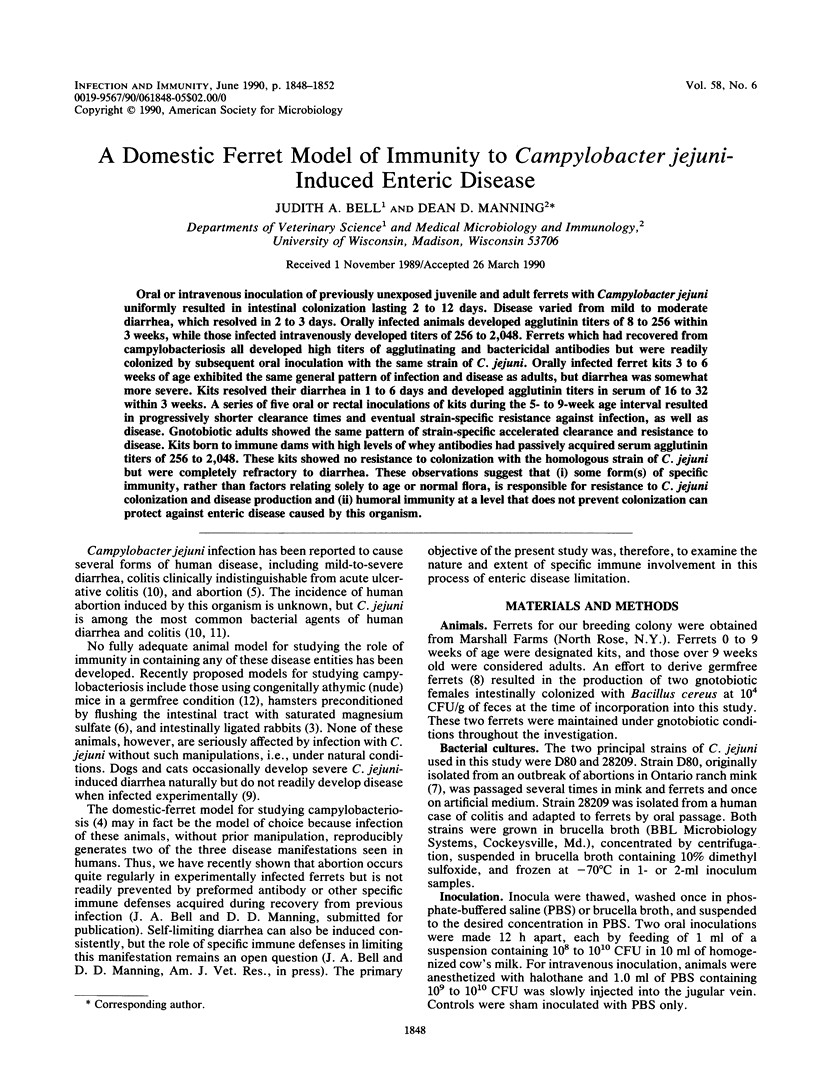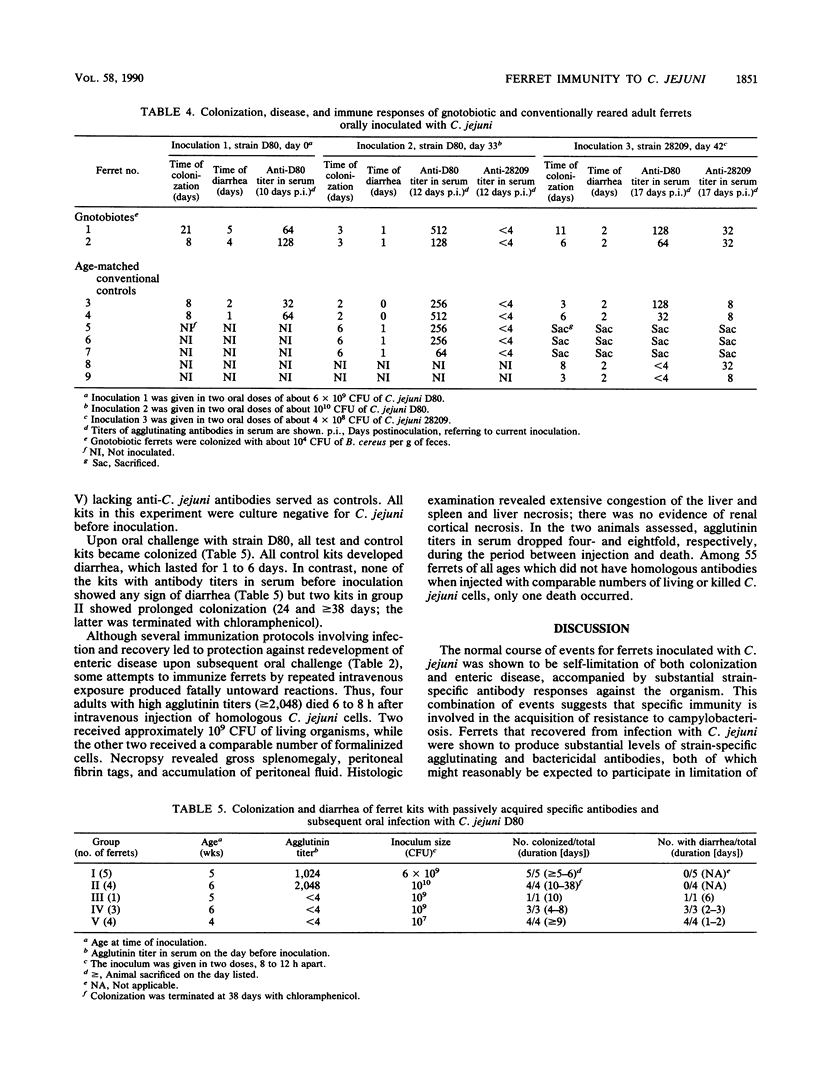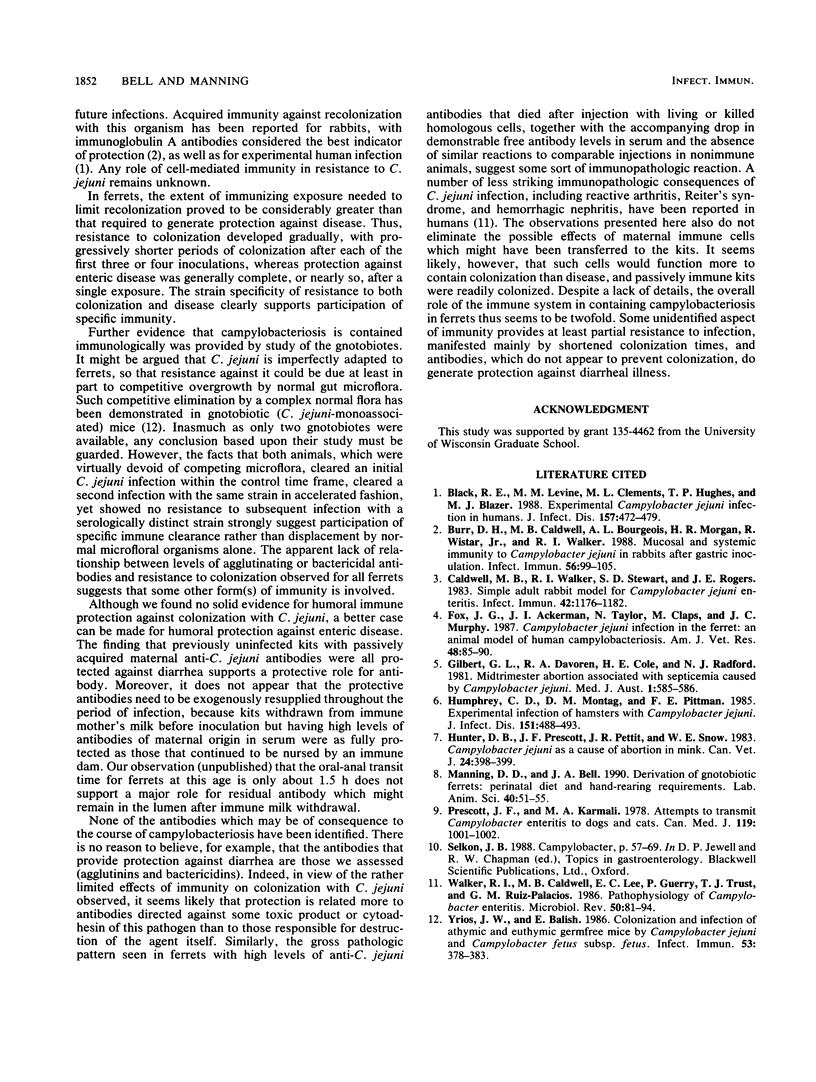Abstract
Oral or intravenous inoculation of previously unexposed juvenile and adult ferrets with Campylobacter jejuni uniformly resulted in intestinal colonization lasting 2 to 12 days. Disease varied from mild to moderate diarrhea, which resolved in 2 to 3 days. Orally infected animals developed agglutinin titers of 8 to 256 within 3 weeks, while those infected intravenously developed titers of 256 to 2,048. Ferrets which had recovered from campylobacteriosis all developed high titers of agglutinating and bacterial antibodies but were readily colonized by subsequent oral inoculation with the same strain of C. jejuni. Orally infected ferret kits 3 to 6 weeks of age exhibited the same general pattern of infection and disease as adults, but diarrhea was somewhat more severe. Kits resolved their diarrhea in 1 to 6 days and developed agglutinin titers in serum of 16 to 32 within 3 weeks. A series of five oral or rectal inoculations of kits during the 5- to 9-week age interval resulted in progressively shorter clearance times and eventual strain-specific resistance against infection, as well as disease. Gnotobiotic adults showed the same pattern of strain-specific accelerated clearance and resistance to disease. Kits born to immune dams with high levels of whey antibodies had passively acquired serum agglutinin titers of 256 to 2,048. These kits showed no resistance to colonization with the homologous strain of C. jejuni but were completely refractory to diarrhea. These observations suggest that (i) some form(s) of specific immunity, rather than factors relating solely to age or normal flora, is responsible for resistance to C. jejuni colonization and disease production and (ii) humoral immunity at a level that does not prevent colonization can protect against enteric disease caused by this organism.
Full text
PDF




Selected References
These references are in PubMed. This may not be the complete list of references from this article.
- Black R. E., Levine M. M., Clements M. L., Hughes T. P., Blaser M. J. Experimental Campylobacter jejuni infection in humans. J Infect Dis. 1988 Mar;157(3):472–479. doi: 10.1093/infdis/157.3.472. [DOI] [PubMed] [Google Scholar]
- Burr D. H., Caldwell M. B., Bourgeois A. L., Morgan H. R., Wistar R., Jr, Walker R. I. Mucosal and systemic immunity to Campylobacter jejuni in rabbits after gastric inoculation. Infect Immun. 1988 Jan;56(1):99–105. doi: 10.1128/iai.56.1.99-105.1988. [DOI] [PMC free article] [PubMed] [Google Scholar]
- Caldwell M. B., Walker R. I., Stewart S. D., Rogers J. E. Simple adult rabbit model for Campylobacter jejuni enteritis. Infect Immun. 1983 Dec;42(3):1176–1182. doi: 10.1128/iai.42.3.1176-1182.1983. [DOI] [PMC free article] [PubMed] [Google Scholar]
- Fox J. G., Ackerman J. I., Taylor N., Claps M., Murphy J. C. Campylobacter jejuni infection in the ferret: an animal model of human campylobacteriosis. Am J Vet Res. 1987 Jan;48(1):85–90. [PubMed] [Google Scholar]
- Gilbert G. L., Davoren R. A., Cole M. E., Radford N. J. Midtrimester abortion associated with septicaemia caused by Campylobacter jejuni. Med J Aust. 1981 May 30;1(11):585–586. doi: 10.5694/j.1326-5377.1981.tb135843.x. [DOI] [PubMed] [Google Scholar]
- Humphrey C. D., Montag D. M., Pittman F. E. Experimental infection of hamsters with Campylobacter jejuni. J Infect Dis. 1985 Mar;151(3):485–493. doi: 10.1093/infdis/151.3.485. [DOI] [PubMed] [Google Scholar]
- Hunter D. B., Prescott J. F., Pettit J. R., Snow W. E. Campylobacter jejuni as a Cause of Abortion in Mink. Can Vet J. 1983 Dec;24(12):398–399. [PMC free article] [PubMed] [Google Scholar]
- Manning D. D., Bell J. A. Derivation of gnotobiotic ferrets: perinatal diet and hand-rearing requirements. Lab Anim Sci. 1990 Jan;40(1):51–55. [PubMed] [Google Scholar]
- Prescott J. F., Karmali M. A. Attempts to transmit campylobacter enteritis to dogs and cats. Can Med Assoc J. 1978 Nov 4;119(9):1001–1002. [PMC free article] [PubMed] [Google Scholar]
- Walker R. I., Caldwell M. B., Lee E. C., Guerry P., Trust T. J., Ruiz-Palacios G. M. Pathophysiology of Campylobacter enteritis. Microbiol Rev. 1986 Mar;50(1):81–94. doi: 10.1128/mr.50.1.81-94.1986. [DOI] [PMC free article] [PubMed] [Google Scholar]
- Yrios J. W., Balish E. Colonization and infection of athymic and euthymic germfree mice by Campylobacter jejuni and Campylobacter fetus subsp. fetus. Infect Immun. 1986 Aug;53(2):378–383. doi: 10.1128/iai.53.2.378-383.1986. [DOI] [PMC free article] [PubMed] [Google Scholar]


